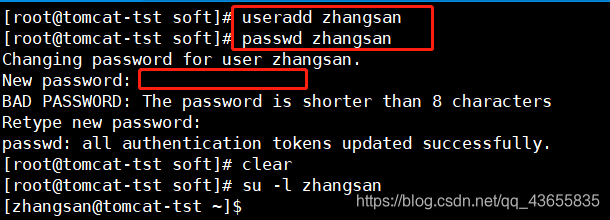
上一篇:ElasticSearch(1)—基础概念
1.下载ElasticSearch
下载ElasticSearch链接
2.安装ElasticSearch
要求:ElasticSearch要求JDK必须是1.8以上
这里我下载的是linux版本的elasticSearch的压缩包:

将此压缩包上传到Linux中:
2.1 解压缩文件
tar -zxvf elasticsearch-7.6.0-linux-x86_64.tar.gz
2.2 移动解压缩之后的文件到/usr/local/目录下
mv elasticsearch-7.6.0 /usr/local/
2.3 新建一个普通用户
ElasticSearch无法使用root用户启动,所以需要创建一个普通用户。

依次输入以下命令:
useradd zhangsan
passwd zhangsan
输入密码:123456 (输入密码之后可能会显示BAD PASSWORD,这是友情提示不用管)
再次输入密码:123456 (回车之后显示 all authentication tokens updated successfully,用户创建成功)
2.4 给新建用户赋予权限
chown -R zhangsan /usr/local/elasticsearch-7.6.0/

2.5 切换用户
切换使用的用户账号:
su -l zhangsan
2.6 开启ElasticSearch
ElasticSearch开启方式分为两种:
1. 种是使用默认配置开启单机版,这种一般是我们自己玩玩儿。
2. 自定义配置文件,工作中一般使用config自定义配置文件来启动。
一、开启默认配置单机版
/usr/local/elasticsearch-7.6.0/bin/elasticsearch

2.7 检查是否启动成功
新开一个Linux窗口:

在新开启的窗口输入下面的命令:
curl -XGET 'http://127.0.0.1:9200'
如果显示如下,则表明ElasticSearch开启成功:

二、开启自定义配置版
这种开启方式是我们实际工作中使用的比较多的,Ctrl+C退出刚才开启的ElasticSearch服务。并输入下面命令进入config目录:
cd /usr/local/elasticsearch-7.6.0/config

在config目录中,有一个配置文件elasticsearch.yml,
2.8 elasticsearch.yml配置文件详解
输入下面命令开始编辑配置文件:
vim elasticsearch.yml
按照下面的配置文件中的内容进行相应的修改:
# ======================== Elasticsearch Configuration =========================
#
# NOTE: Elasticsearch comes with reasonable defaults for most settings.
# Before you set out to tweak and tune the configuration, make sure you
# understand what are you trying to accomplish and the consequences.
#
# The primary way of configuring a node is via this file. This template lists
# the most important settings you may want to configure for a production cluster.
#
# Please consult the documentation for further information on configuration options:
# https://www.elastic.co/guide/en/elasticsearch/reference/index.html
#
# ---------------------------------- Cluster -----------------------------------
#
# Use a descriptive name for your cluster:
#
cluster.name: test_cluster
#
# ------------------------------------ Node ------------------------------------
#
# Use a descriptive name for the node:
#
node.name: node-1
#
# Add custom attributes to the node:
#
#node.attr.rack: r1
#
# ----------------------------------- Paths ------------------------------------
#
# Path to directory where to store the data (separate multiple locations by comma):
#
path.data: /home/zhangsan/data/elastic
#
# Path to log files:
#
path.logs: /home/zhangsan/logs/elastic
#
# ----------------------------------- Memory -----------------------------------
#
# Lock the memory on startup:
#
#bootstrap.memory_lock: true
#
# Make sure that the heap size is set to about half the memory available
# on the system and that the owner of the process is allowed to use this
# limit.
#
# Elasticsearch performs poorly when the system is swapping the memory.
#
# ---------------------------------- Network -----------------------------------
#
# Set the bind address to a specific IP (IPv4 or IPv6):
#
# network.host: 192.168.0.1
network.host: 0.0.0.0
#
#
# Set a custom port for HTTP:
#
http.port: 9200
#
# For more information, consult the network module documentation.
#
# --------------------------------- Discovery ----------------------------------
#
# Pass an initial list of hosts to perform discovery when new node is started:
# The default list of hosts is ["127.0.0.1", "[::1]"]
#discovery.zen.ping.unicast.hosts: ["host1", "host2"]
cluster.initial_master_nodes: ["node-1"]
# Prevent the "split brain" by configuring the majority of nodes (total number of master-eligible nodes / 2 + 1):
#
#discovery.zen.minimum_master_nodes: 3
#
# For more information, consult the zen discovery module documentation.
#
# ---------------------------------- Gateway -----------------------------------
#
# Block initial recovery after a full cluster restart until N nodes are started:
#
#gateway.recover_after_nodes: 3
#
# For more information, consult the gateway module documentation.
#
# ---------------------------------- Various -----------------------------------
#
# Require explicit names when deleting indices:
#
#action.destructive_requires_name: true
http.cors.enabled: true
http.cors.allow-origin: "*"
node.master: true
node.data: true
2.9 修改jvm参数
使用root账户输入以下命令:
1.在ES的config目录下的jvm.options中修改:
-Xms1g 改为-Xms128m
-Xmx1g 改为-Xmx128m
2.修改内存大小
内存权限报错
3.修改如下配置:
vi /etc/security/limits.conf
添加如下内容:
-
soft nofile 65536
-
hard nofile 131072
-
soft nproc 2048
-
hard nproc 4096
以上第二步和第三步完成之后输入命令sysctl -p立即执行。
3 重启服务
注意:-d表示后台启动,不加则表示前台启动
/usr/local/elasticsearch-7.6.0/bin/elasticsearch -d

输入命令jps,查看是否有ElasticSearch的进程

如果有则表示开启成功。